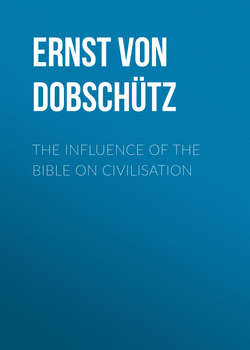The Influence of the Bible on Civilisation

Реклама. ООО «ЛитРес», ИНН: 7719571260.
Оглавление
Ernst von Dobschütz. The Influence of the Bible on Civilisation
PREFACE
I. THE BIBLE MAKES ITSELF INDISPENSABLE FOR THE CHURCH (UNTIL 325 A. D.)
II. THE BIBLE BEGINS TO RULE THE CHRISTIAN EMPIRE (325-600 A. D.)
III. THE BIBLE TEACHES THE GERMAN NATIONS (500-800 A. D.)
IV. THE BIBLE BECOMES ONE BASIS OF MEDIÆVAL CIVILISATION (800-1150 A. D.)
V. THE BIBLE STIRS NON-CONFORMIST MOVEMENTS (1150-1450)
VI. THE BIBLE TRAINS PRINTERS AND TRANSLATORS (1450-1611)
VII. THE BIBLE RULES DAILY LIFE (1550-1850)
VIII. THE BIBLE BECOMES ONCE MORE THE BOOK OF DEVOTION
Отрывок из книги
There is a small book; one can put it in one's pocket, and yet all the libraries of America, numerous as they are, would hardly be large enough to hold all the books which have been inspired by this one little volume. The reader will know what I am speaking of; it is the Bible, as we are used to call it – the Book, the book of mankind, as it has properly been called. It has been commented upon, treated in every way, but, curious to say, hardly any one has attempted to trace its history through the centuries and mark the influence which it exerted upon our civilisation.
In order to do this we follow the traces of the Bible through the different periods of human or, to speak more accurately, of Christian civilisation. In the first period of Christian history, the time of persecutions during the first three centuries of our era, there is not much to say about the Bible as influencing civilisation. Christianity was but starting on its way and fighting for its place in the world. The Bible could not exert a civilising influence upon a hostile world. But by impressing its value upon the Christian mind it made itself indispensable for the church and thereby laid the foundation for the future development.
.....
Here begins our difficulty: how did they get so many copies? There was an organised book-trade in the ancient world; publishers had their offices, using (instead of printing-presses) slaves who were trained in copying; they had shorthand writers, as well as calligraphers to do the fine writing. But as long as Christianity was still an oppressed religion it is doubtful if the Bible was among the books which publishers would care to take. The Christians were, most of them, poor people who could not spend much money for procuring Bibles. Besides, it was no easy thing to get a complete Bible. At that time the books were still written on papyrus rolls, not in book form. Only one side of the papyrus could be used; the roll would become unwieldy if too long. So, in order to get all the books of the Old and the New Testament, at least two dozen rolls had to be written. Maybe a simple Christian copied for himself one gospel or some letters or even one or more books from the Old Testament. There are preserved on papyrus some unfinished attempts which show what hard work it was (Plate I). We can scarcely imagine a man going with this heavy hand through all the books of the Bible.
We are told that wealthy Christians helped their brethren by procuring copies for them. Origen, the greatest Bible scholar of the ancient church, is said to have been supported by a rich admirer, who put at his disposal a number of slave copyists. With their help he succeeded in creating one of the greatest works which Bible criticism ever undertook, his so-called Hexapla, which is a comparison of more than six various Greek translations of the Old Testament. Scholars in the nineteenth century held that scarcely more than one copy of this enormous work had ever been written, but by recent discoveries we know that it was copied several times (Plate II). A later admirer of Origen, Pamphilus, is said always to have carried with him several rolls in order to provide poor brethren. Now that was the third century. Christianity had already begun to spread among the higher classes and to become a feature in the world's life.
.....